Q&A – Ask Neil: September 26, 2024
(Please read these instructions carefully.)
Before you post your question, please look at recent issues to see if someone else has already asked it. You might find your answer there.
How to submit your question…
(Note: You may need to allow a pop-up window to come up in order to get the link for sending your photo(s). If you have already submitted your question and didn’t see the pop-up window, please click here.)
• Click the link provided below to post your question. After you submit your question, a new window will pop up giving you the address to which you can e-mail a SHARP, HIGH-RESOLUTION PHOTO to accompany your question. Please DO NOT SEND THUMBNAIL PHOTOS in case I need to zoom in to see things.
• Click here to post your question.
• Please ONLY POST YOUR QUESTION ONE TIME. We can only accept a set number of questions each week, and when we get duplicates it costs other people their chances.
• One question per reader, please.
• Please use this only for posting questions – not for standard emails.
• Watch for your answer in the following week’s e-gardens.
• I choose those of greatest general interest. For example, plant IDs seldom make the cut.
• I must have your first name or initials.
• I must have your city or county. (Texas is a very large state.)
QUESTION 1
WHAT IS HAPPENING TO MY PROSTRATE JUNIPER?
Question: We have a prostrate juniper groundcover in a sun/shade portion of our yard. It has done well for 20-plus years. I have watered it faithfully, and no herbicides have been applied nearby. Now some ends are turning yellow, then brown. Any idea what is going on? Luther O., Seguin.
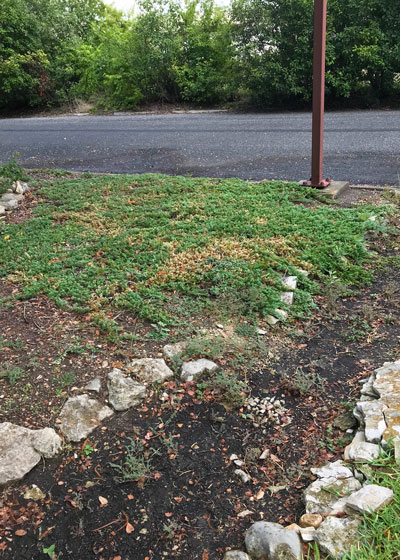
Answer: I would be suspicious of spider mites. They are common on junipers of all types. They’re almost microscopic, so you can have a huge population and not realize it. Clip one 5-inch piece of the yellowing ends (not a dead, brown piece) and thump it against a clean sheet of white paper at a time when the twig is dry. You will see all kinds of flecks fall off the twig and onto the paper. Some will be tiny pieces of juniper needles, while some may be splashes of soil. But if many of them start scurrying around, those would be the spider mites. If you care to look at them with a magnifying glass, you’ll see that they have eight legs, not six like insects. They are the most damaging pests of a very large assortment of landscape and garden plants ranging from marigolds and crotons to green beans and tomatoes. If you see them, apply a general-purpose insecticide labeled for control of spider mites, red spiders, etc. Apply it with enough force that you coat all surfaces of the juniper twigs. It won’t cause the browned twigs to green back up, but it should stop the further development of the problem. It’s also important to note that the species of mite that attacks junipers shows up notably earlier than most other spider mites, often in late January or early February. Watch for spots in your plants to start losing their vivid green color and turning olive drab. That’s the time to start checking.
QUESTION 2
ARE LIQUID PRE-EMERGENT PRODUCTS GOOD FOR HOME GARDENERS?
Question: What is your opinion of the efficacy of Prodiamine and other liquid pre-emergents in stopping germination of annual grassy weeds such as Poa annua? Russell B., Frisco.
Answer: It’s only a personal opinion, but I feel that granular products are easier for consumers to apply accurately and evenly. If you’ve had good results with a liquid product, by all means, go with it. As I noted in my information of control of annual bluegrass (Poa annua), the granular materials are not giving perfect control. Prodiamine might be a good alternative if you are comfortable using a liquid.
QUESTION 3
IF I MULCH ALL MY GRASS CLIPPINGS BACK INTO MY LAWN, WHEN CAN I CUT BACK ON THE FEEDINGS?
Question: For the past 4 years I have mulched all of my grass clippings and fall leaves back into my bermuda lawn 100 percent of the time. I believe one of the benefits of mulching is soil quality improvement. When may I begin reducing fertilizer application rate or frequency? M A C, Tarrant County.
Answer: Please read back over your recent issues of e-gardens. You’ll see several times where I have advised you against mulching fallen leaves back into the lawn at the peak leaf-fall time of late October into early November. For most landscapes, there is just too much organic matter available at one time. Bag those clippings for that 2- or 3-week period and use them beneath shrubs, in the vegetable garden, or in the compost pile.
Remember that one of your main goals in returning clippings to the lawn is to re-introduce organic matter to the soil. That’s every bit as important as the nutrients you’re putting back in. As for when you can cut back on rates and frequency of feeding, only regular soil tests will give you that information. It will be gradual.
QUESTION 4
WHEN AND BY HOW MUCH SHOULD MY TEXAS SAGE PLANTS BE PRUNED?
Question: I have some beautiful, but crazy-growing Texas sage. I need to trim them. When is the right time, and how far back should they be trimmed? Marlene A., Brazos County.
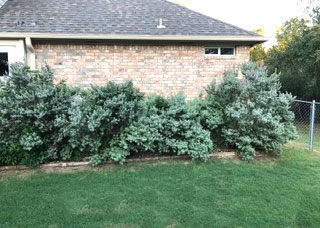
Answer: The best time to prune them is toward the end of the winter (early February for Brazos County) so that you can avoid most potential extreme cold. As for how much, I would use the shortest plant as your guide. I would use hand shears and loppers to prune the other three back to match its height. You don’t want to use hedge trimmers to do the cuttings because it would leave them looking very bare. By trimming one branch at a time you can trim them carefully enough that you will hardly be able to see that they have been pruned. Leave no stubs. Make each cut flush with a surviving branch. Allow 20 to 30 minutes to tailor each plant. People who rush this job end up butchering their plants into globes or cubes. You want them to look natural when you’re finished.
QUESTION 5
SHOULD I REPLACE MY NELLIE R. STEVENS HOLLY? HOW ABOUT A VELMA’S ROYAL DELIGHT CRAPE MYRTLE?
Question: My Nellie R. Stevens holly has seen better days. Should I try to save it or replace it? I’m considering a 6- to 8-foot crape myrtle. Have you ever heard of Velma’s Royal Delight? It gets some shade from a Shumard red oak. Steve R., Tarrant County.

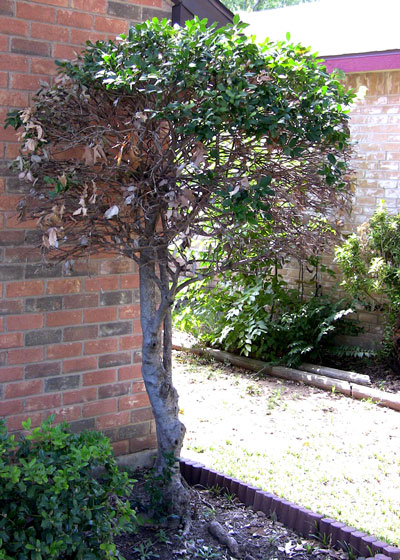
Answer: Velma’s Royal Delight is a spectacular crape myrtle with brilliant magenta color and the height you described. It’s one of the most winter hardy varieties we grow. However, you don’t have enough horizontal room for any crape myrtle. It’s too close to the bed edging. I would recommend an Oakland holly or a Willowleaf holly trained as a pyramid. Either would handle the partial shade and limited space. Water the new plant every two days during the growing season for the first two or three years.
QUESTION 6
HOW CAN I CONTROL SCALE ON MY PURPLE WINTERCREEPER EUONYMUS?
Question: I have been dealing with euonymus scale in my purple wintercreeper euonymus since last year and I can’t seem to stop it. I’ve used Imidacloprid systemic and foliar spray, dormant oil spray, and I trim it frequently. The planting still seems to be growing rapidly. I have to trim it every few weeks to keep it off the side of the house and out of the hollies. Help! Daniel D., Keller.
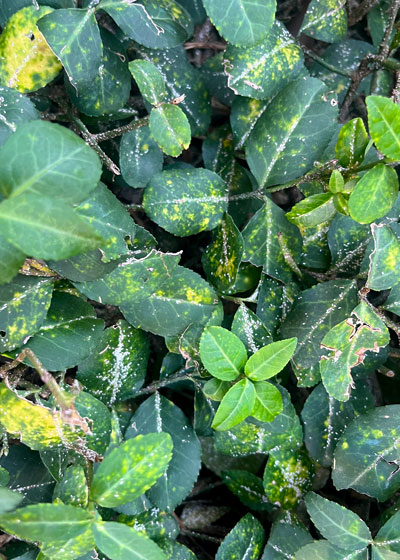
Answer: My money would be on the Imidacloprid. I’ve had scale on hollies and wintercreeper a couple of times each, and when I applied Imidacloprid in early spring (March/April) it kept the new growth clean. As the old leaves fell off, they brought the insects down to the ground with them. I kept them blown out of the planting and picked them up with my lawn mower. I have always found that euonymus scale was 10 times worse on growth that was ascending as compared to wintercreeper growing flat on the ground.
QUESTION 7
WHAT IS THIS WEED, AND WHAT CAN I DO TO CONTROL IT?
Question: What is this weed that is starting to take over all the bare spots in my lawn? What can I use to control it, and is it too late for this year? Dan S., Tarrant County.
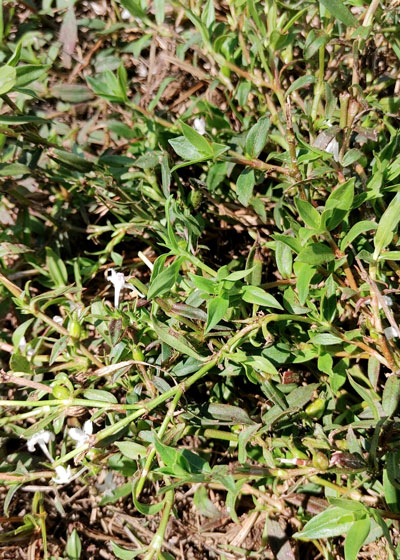
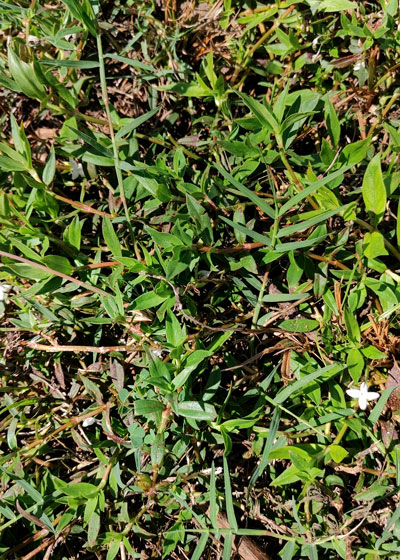
Answer: Congratulations! You have Virginia buttonweed, one of the most difficult weeds to control. You’ll want to apply one of the herbicides containing a blend of 2,4-D and other active ingredients.
Louisiana State University has a very good writeup on Virginia buttonweed and how you can deal with it. Rather than just copying all that information here, I decided simply to link you directly to it.
